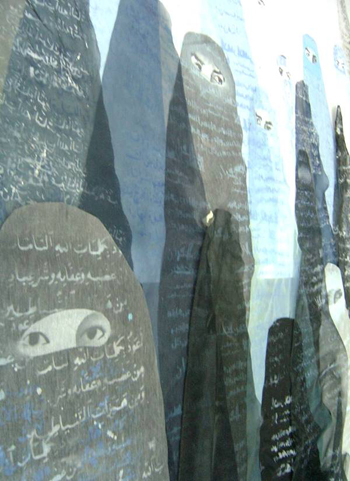A Curtain Between Worlds
Georgina Choueiri Paints the Veil
To many in the Western world, the wearing of the hijab, or veil, by Muslim women is a mysterious and controversial tradition. Artist Georgina Choueiri--born into the Lebanese Civil War and raised in Beirut, the United States and Spain--was also intrigued by the custom.
In her series of luminous paintings and murals titled, The Veil, Choueiri explores the view from inside out and outside in.

Between 1999 and 2001, Georgina traveled across North Africa and the Middle East to Pakistan on a work assignment, interviewing veiled women along the way. "I was able to enter the private life of many women I otherwise would not have had the chance to meet. This helped dissolve the barriers once created by that piece of cloth."
On her return home, Georgina, who studied art in Lebanon and Spain, found herself artistically drawn to the veil. Eventually she devoted herself completely to the subject, creating a series of acrylic paintings and mixed media murals of women in veils. "I am inspired by found material and one day I found transparent veils left in a bag on the street; they were even shaped in the form of a veiled woman. This inspired the beginning of The Veils series," Georgina explains. The ethereal quality of the images retains the mystery of the veiled woman, but the softness and subtle strength in the series also reveal a sense of humanity and the artist's affection for her subject.
Now living in Beirut, Georgina reflects on herself as an artist, as well as the origins and impact of The Veil.
How did you come to be an artist? What subjects are you most drawn to?
I was having many existential questions and felt a need to paint it all out. Six years ago, I left my life and job in Beirut and went to Barcelona to paint. Barcelona was such an inspiring city; it opened my eyes to many new ways of artistic expression. I was especially interested in exploring my interior world. One of the subjects that kept surfacing was the veil -- the experience and impressions I had from living in the Arab world were asking to come out.
Having grown up in a Christian household, why did you feel the hijab was an important subject for you to explore?
It was important for me to challenge my own perception and break the stereotypes associated with the veil. It made me reconsider the barriers -- not only physical, but religious, social, political and psychological -- around this piece of cloth.
You interviewed women in Saudi Arabia, the United Arab Emirates, Pakistan, Syria, and Lebanon. What did you learn from them? Did your conversations with these women affect how you approached this series?
Having the chance to interview many women who wore the veil was important in order to learn their side of the story. I found out that some found it gave them more respect and freedom, for example, from being looked upon as a sex symbol, which in their opinion was an issue many women face in Western culture.
Has this project changed your views on the veil as a religious and political symbol?
I think it should be the woman's right to choose whether or not to wear the hijab, and not something imposed on her by religious laws interpreted by men - nowhere in the Quran does it say that a woman must wear a hijab and the little that is mentioned on the matter is subject to interpretation. That becomes an extension of many other issues around the rights of Arab women.
Why do you think painting is such an effective way to explore and express the complexities of this issue?
Words can be quite limiting in trying to convey certain emotions or impressions. When it comes to The Veil, the entire process was a reflection around the theme, I wasn't trying to say something specific as much as I felt a need to explore the subject. Art gives me the freedom to do that, without the weight that words can carry.
You exhibited in a group mural show at La Santa in Barcelona, and then later exhibited your veil paintings in Beirut. Did you perceive a distinct difference in the reaction to the exhibition of your work in Beirut as opposed to in Barcelona?
In Barcelona, the viewers looked upon this subject with outsider's curiosity -- as being in a world very far from their own-- showing that the veil still remains a curtain between both worlds. In Beirut, in an Arab country, the theme is close to home. Of the people who attended the exhibition only a few wore the veil, with whom I had the most interesting conversations around the subject.
Back in Beirut, Georgina is currently working on a short documentary film about women and spiritual healing in the Middle East and Sub-Saharan Africa. She continues to exhibit her paintings in galleries in Beirut.




